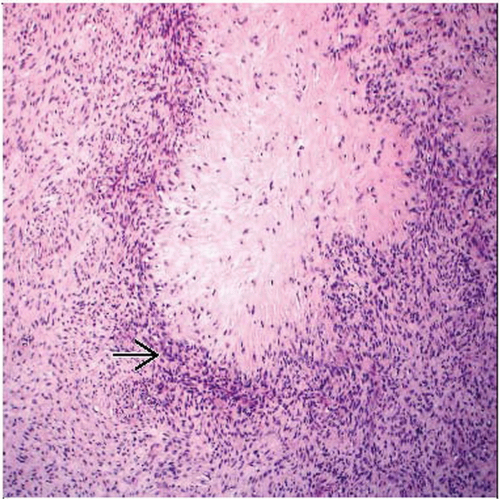Low-Grade Fibromyxoid Sarcoma
Khin Thway, BSc, MBBS, FRCPath
Key Facts
Terminology
Malignant fibroblastic neoplasm composed of bland spindles in collagenous matrix, often with prominent collagenous nodules
Characterized by specific translocations producing fusion oncogenes
Clinical Issues
Adults (typically in 4th decade)
More common in males
Mainly deep-seated but can also occur superficially
Proximal extremities (especially lower limbs) and trunk
Rarely other locations, including viscera
Recurrence rates of up to 21%
Recurrence is lower in superficial cases
Metastatic rate of approximately 30% in genetically confirmed cases
Microscopic Pathology
Whorled distributions of bland fibroblasts
Collagenous or myxoid matrix, often in distinct zones
Owing to bland morphology, tumors often mistaken for variety of benign or low-grade neoplasms
Ancillary Tests
CD34 positivity in some cases
Occasional EMA and claudin-1 positivity, which can make distinction from perineurioma difficult
Balanced translocations
t(7;16)(q32-34;p11) FUS, CREB3L2
t(11;16)(p11;p11) FUS, CREB3L1
TERMINOLOGY
Abbreviations
Low-grade fibromyxoid sarcoma (LGFMS)
Synonyms
Fibrosarcoma, fibromyxoid type; hyalinizing spindle cell tumor with giant rosettes
Definitions
Malignant fibroblastic neoplasm composed of bland spindle cells in collagenous and myxoid matrix, often with prominent collagenous nodules
Characterized by specific translocations producing fusion oncogenes
Despite histologically low-grade morphology, up to 30% can metastasize
ETIOLOGY/PATHOGENESIS
Characteristic Translocations
Produce chimeric fusion genes
Cellular origin still unknown but mesenchymal neoplasm with cells of fibroblastic type
CLINICAL ISSUES
Epidemiology
Incidence
True incidence unknown
Tumor probably underreported in literature due to its morphologic resemblance to other benign and malignant tumors
Age
Adults (typically in 4th decade), but wide age distribution
Significant proportion occur in patients < 18 years old
Gender
M > F
Site
Mainly deep-seated but can also occur in dermis and subcutis
Proximal extremities (especially lower limbs) and trunk
Rarely other locations, including viscera
Superficial lesions have higher incidence in childhood
Presentation
Painless mass
Many are of long duration
Treatment
Surgical approaches
Wide excision
Long-term follow-up is mandatory, in view of potential for late metastases
Prognosis
Recurrence rates of up to 21%
Recurrence is lower in superficial cases
Metastatic rate of approximately 30% in genetically confirmed cases
> 80% of metastases appeared after 9 years
No reported metastases in superficial tumors
MACROSCOPIC FEATURES
General Features
Well-defined mass
White cut surface, often with glistening myxoid areas
Sometimes cystic foci, but necrosis rare
Stay updated, free articles. Join our Telegram channel

Full access? Get Clinical Tree







